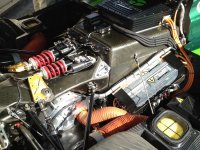- Home
- Forums
- VW California T5 T6 & T6.1 Specific Sections
- VW California T5,T6 & T6.1 Specific Sections
- Electrical
You are using an out of date browser. It may not display this or other websites correctly.
You should upgrade or use an alternative browser.
You should upgrade or use an alternative browser.
How-To install DC-DC charger to replace VW Split Charge relay
- Thread starter Loz
- Start date
-
- Tags
- redarc split charge vsr
Skewif
It’s not what you have, it's where you wake up.
It will cause no harm being hooked up for long periods. Lead acid batteries love being fully charged and the mains hookup charger is a top quality 3 stage unit that will maintain full charge without ill effect.Is there any reason not to leave the van plugged in to hookup at home when not in use (could be weeks at a time?) T6, with bluemotion tech
Razor Crest
VIP Member
Is there any reason not to leave the van plugged in to hookup at home when not in use (could be weeks at a time?) T6, with bluemotion tech
I would be interested to know the answer to this.
CampervanTime
Top Poster
VIP Member
It will cause no harm being hooked up for long periods. Lead acid batteries love being fully charged and the mains hookup charger is a top quality 3 stage unit that will maintain full charge without ill effect.
Great, that being the standard VW one already fitted to the van?
Skewif
It’s not what you have, it's where you wake up.
Yes. Lead acid batteries are best kept fully charged. Assuming VW still fit a 3 stage charger the last stage of charging is float. Float purely tops up/ counteracts the internal losses within the battery. A lead acid battery can be kept on float indefinitely without harm.Great, that being the standard VW one already fitted to the van?
CampervanTime
Top Poster
VIP Member
Thank you
headsuk
I've been pondering about doing this for sometime to my ocean Just fitted a ablemail from Martyn (travelvolts) unit to my son's my17 conversion and it works well....
sidepod
Super Poster
Lifetime VIP Member
- Messages
- 6,946
- Vehicle
- T4 PopTop
Perhaps some confusion here. Leisure batteries are not (or should not be) lead acid but Gel type. Starter battery is leadvacid obvs.Yes. Lead acid batteries are best kept fully charged. Assuming VW still fit a 3 stage charger the last stage of charging is float. Float purely tops up/ counteracts the internal losses within the battery. A lead acid battery can be kept on float indefinitely without harm.
No problem at all leaving van on hook up.
Skewif
It’s not what you have, it's where you wake up.
Gel is a type of lead acid battery.Perhaps some confusion here. Leisure batteries are not (or should not be) lead acid but Gel type. Starter battery is leadvacid obvs.
No problem at all leaving van on hook up.
WelshGas
Retired after 42 yrs and enjoying Life.
Super Poster
Lifetime VIP Member
Or fit a Solar Panel. No problem keeping the Leisure Batteries topped up during winter. Obviously only of use if the vehicle is parked outside with no overhead obstacles.
Loz
Super Poster
Lifetime VIP Member
All 3 batteries are the same AGM on the ocean.
Amarillo
Tom
Super Poster
VIP Member
And south of 66°33′47.1″ North.Or fit a Solar Panel. No problem keeping the Leisure Batteries topped up during winter. Obviously only of use if the vehicle is parked outside with no overhead obstacles.
Follow my blog: www.au-revoir.eu
sidepod
Super Poster
Lifetime VIP Member
- Messages
- 6,946
- Vehicle
- T4 PopTop
“Most DC-DC chargers draw a higher rate of amperage from the alternator than would be supplied if you let the alternator ‘push’ down the cable. This can be up to 40A or more per hour, quickly replenishing the house battery system.”
Hmmmmmm???
Hmmmmmm???
I
Ian Robinson
Guest User
Very interesting thread Loz. May I ask under what circumstances does the split change relay allow electrical flow from leisure batteries back into the engine battery system please. Whilst driving sometimes the charging rate goes from day positive 8 amps and then drops to pretty much nothing for a while at low revs (presumably blue motion control of alternator?) but I have never seen anything less than 0.2 amp positive.
Skewif
It’s not what you have, it's where you wake up.
Obviously you can't "push" electrons. Your point is??“Most DC-DC chargers draw a higher rate of amperage from the alternator than would be supplied if you let the alternator ‘push’ down the cable. This can be up to 40A or more per hour, quickly replenishing the house battery system.”
Hmmmmmm???
sidepod
Super Poster
Lifetime VIP Member
- Messages
- 6,946
- Vehicle
- T4 PopTop
I was raising an eyebrow at the amount of juice it pulls. Surely this will override the blue motion thing, not that that matters.
Also the article talks of heat in the cables and volt drop making siting of the unit important.
Interesting stuff.
Also the article talks of heat in the cables and volt drop making siting of the unit important.
Interesting stuff.
Loz
Super Poster
Lifetime VIP Member
“Most DC-DC chargers draw a higher rate of amperage from the alternator than would be supplied if you let the alternator ‘push’ down the cable. This can be up to 40A or more per hour, quickly replenishing the house battery system.”
Hmmmmmm???
That is an odd quote you found there, because if you have an alternator running it’s charging the house battery.
The alternator could be charging at 80-100A but a dc-dc charger is typically 20-60 depending on what model you have. So the alternator can easily put more into the house battery than the dc-dc can take.
I think what that is trying to say is a dc-dc charger draws its boost current for longer and more consistently than an alternator.
Its true that some dc-dc chargers and VSR’s will ckeep charging until the house/starter battery reaches 12.6v after the engine has stopped. But the latest chargers like the one I used above also have a control wire that shuts it off as soon as the engine stops so your starter battery will not be plundered at all.
VW should really have upgraded the leisure electrics by replacing the relay with a DC-DC charging system when the T6 was designed.
Loz
Super Poster
Lifetime VIP Member
I was raising an eyebrow at the amount of juice it pulls.
Also the article talks of heat in the cables and volt drop making siting of the unit important.
Interesting stuff.
Yes very interesting, I have actually down rated by using smaller fuses but the current carrying capacity is also time based as cables will get warn if their capacity is exceed but ‘you’ get away with this if its for short bursts. i.e. starter cables are not that big but the 100s of cranking amps are only present for a few seconds.
Now, electric cars.... have you seen the size of those and they parallel them up!!
Edit: attachment for you sidepod

Last edited:
El Greco
VIP Member
Loz, does this arrangement allow the engine battery to be charged by the EHU?
Skewif
It’s not what you have, it's where you wake up.
My understanding is smart alternators are variable voltage rather than on / off. So yes more power/fuel will be needed to run DC-DC but you end up with fuller house batts in less time. I'm not sure about this 40A mentioned as AGM lead acid batteries prefer to be charged at no more than 10% of total capacity so around 15A max would be best.
Overall it looks like an excellent system that is particularly well suited to Bluemotion. Seems like a no brainer that these should be fitted as standard if trying to charge leisure batts from a smart alternator.
Indeed interesting stuff.
Overall it looks like an excellent system that is particularly well suited to Bluemotion. Seems like a no brainer that these should be fitted as standard if trying to charge leisure batts from a smart alternator.
Indeed interesting stuff.
Loz
Super Poster
Lifetime VIP Member
Nothing changes in that respect.Loz, does this arrangement allow the engine battery to be charged by the EHU?
to clarify:
This unit itself does not provide any charging on EHU.
It also does not interfere with the onboard charger that is powered by the EHU
burnercan
Lifetime VIP Member
Excellent write up Loz, many thanks!
sidepod
Super Poster
Lifetime VIP Member
- Messages
- 6,946
- Vehicle
- T4 PopTop
So it would appear that the regen braking system is a bit crude (cheap).
Leaving headroom in the battery is a bit of a cop out?
A more complex system (F1) would harvest the spare regen charge and use it to spin up the turbo.
Surely the MGU can be configured to freewheel once the battery is at 100%?
Spinning up the turbo obvs requires an electric turbo but would surely help with economy?
Leaving headroom in the battery is a bit of a cop out?
A more complex system (F1) would harvest the spare regen charge and use it to spin up the turbo.
Surely the MGU can be configured to freewheel once the battery is at 100%?
Spinning up the turbo obvs requires an electric turbo but would surely help with economy?
Loz
Super Poster
Lifetime VIP Member
Surely the MGU can be configured to freewheel once the battery is at 100%?
Spinning up the turbo obvs requires an electric turbo but would surely help with economy?
I agree, the Bi Turbo would be better if the low pressure turbo was electric with its own battery charged by the regenerative braking.
Similar threads
- Replies
- 6
- Views
- 2K
- Home
- Forums
- VW California T5 T6 & T6.1 Specific Sections
- VW California T5,T6 & T6.1 Specific Sections
- Electrical

About us
The VW California Club is the worlds largest resource for all owners and enthusiasts of VW California campervans.













